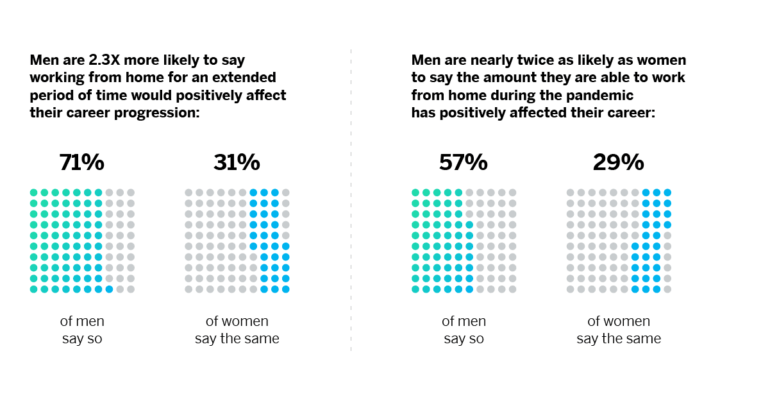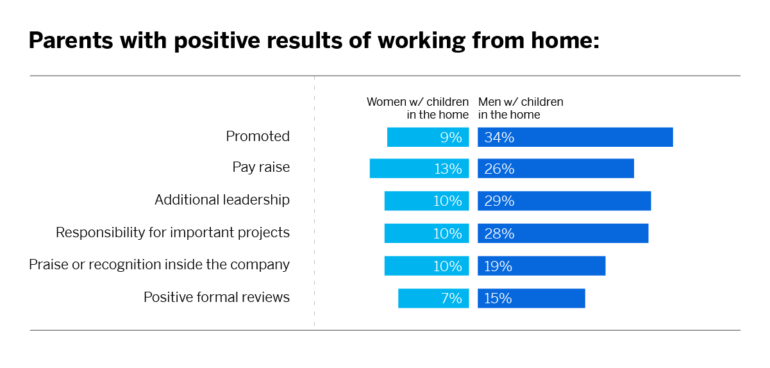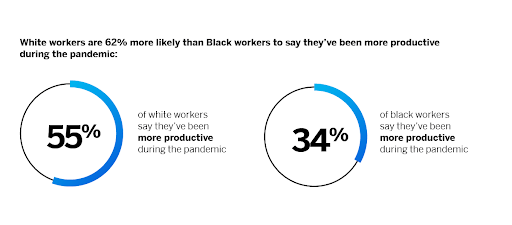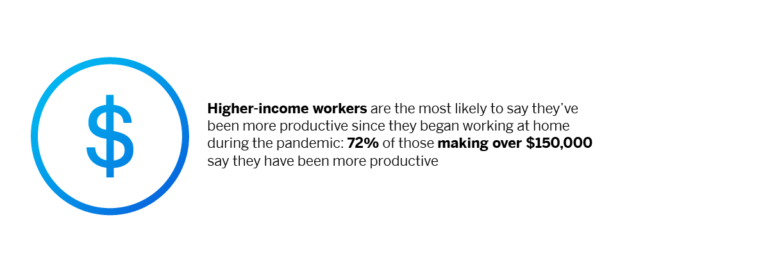Employee Experience
Not in the same boat: Career progression in the pandemic
New study from Qualtrics and theBoardlist finds working during the pandemic disproportionately affects careers of women, parents, and people of color.
COVID-19 has forced everyone to adjust to a new way of life and a new way of working. But the career effects of the global pandemic haven’t been equitable for all workers, according to a new study of more than 1,000 U.S. adults conducted by Qualtrics and theBoardlist.
Women working remotely in a home with children are less likely to say they’ve been more productive since the pandemic than men in the same situation. Men are more likely than women to say that working from home would positively affect their career.
White workers are more likely than Black workers to say they’re more productive working from home, and high-income earners are more likely than those earning less to say the same.
So how has the pandemic affected the lives and careers of different people across the United States?
Increase your company's agility with our market research eBook: Download Now
Gender
Women find working from home to be more detrimental to their professional lives than men:
- Men are nearly twice as likely as women to say the amount they are able to work from home during the pandemic has positively affected their career: 57% of men say it has been positive, while only 29% of women say the same
- 67% of men say they have been more productive since working from home during the pandemic, while 41% of women say the same
- Men are 2.3 times more likely to say working from home for an extended period of time would positively affect their career progression: 71% of men said so, while only 31% of women said the same; though nearly half of women said working from home would neither positively or negatively affect their career, while only 20% of men held that opinion

Men were able to work from home more often than women before the pandemic — and are more likely to say they want to continue after:
- Men are more than twice as likely to say they were occasionally allowed to work from home before COVID-19: 66% of men say they could, while only 31% of women say the same
- The majority of men and women want more work-from-home time in the future: 71% of men say they’d like to work from home more, while 56% of women say the same
Men are more likely than women to say the pandemic has affected men and women equally when it comes to furloughs and layoffs:
- 69% of men say male and female employees were equally impacted by furloughs and layoffs, while 39% of women say the same
- 13% of women say female employees were more likely to be impacted by layoffs or furloughs, while 4% of men say the same
- 8% of men say male employees were more likely to be impacted by layoffs or furloughs, while 2% of women say the same
Men are more likely than women to say their company has added leadership diversity programs because of the coronavirus — and are significantly more likely to say their company places too much emphasis on women in leadership:
- Over half of all men (51%) say their company has added diversity and leadership programs since the pandemic, while only 18% of women say the same
- 35% of men say their company places too much emphasis on women in leadership, while only 8% of women say the same. Over 70% of women say their company places just the right amount of emphasis, while 59% of men say the same. Over 20% of women say their company does not place enough emphasis on women in leadership, while 6% of men say the same
- Half of women (50%) believe having women in leadership is correlated with improved financial performance at their company — while almost half (45%) say they neither agree nor disagree with that statement; 73% of men say having women in leadership correlates with better financial performance, while only 22% say they neither agree nor disagree
Parents
Parents generally feel like the amount they’re able to work from home has positively impacted their careers — though women, less so:
- Nearly 70% of workers with children in the home say working from home has positively impacted their career. Only 29% of workers without children say the same. Workers with children in the home tended to be younger than those without children in the home.
- 57% of women with children at home say it’s been positive, while 27% of women without children said the same
Men with children at home report positive effects on their career much more frequently than women. Among employees that saw at least some benefit from remote work:
- 34% of men with children at home say they’ve received a promotion while working remotely, while only 9% of women with children at home say the same
- 26% of men with children at home say they’ve received a pay raise while working remotely, while only 13% of women with children at home say the same
- 29% of men with children at home say they’ve taken on additional leadership while working remotely, while only 10% of women with children at home say the same
- 28% of men with children at home say they’ve been given responsibility for important projects while working remotely, while only 10% of women with children at home say the same
- 19% of men with children at home say they’ve received praise or recognition inside the company while working remotely, while only 10% of women with children at home say the same
- 15% of men with children at home say they’ve received positive formal reviews while working remotely, while only 7% of women with children at home say the same

Men with children at home are 1.7x more likely than women with children at home to say they’re more productive working remotely:
- 46% of women with children at home say they’ve been more productive working at home during the pandemic, while 77% of men with children say the same. Only 40% of women with no children at home say they’ve been more productive during the pandemic
Here’s why men with children at home report feeling more productive during quarantine:
- 41% say they have fewer noises and distractions, like emails, phone calls, and requests from colleagues, while 19% of women with children at home say the same
- 30% say they have more efficient workflows, while 12% of women with children at home say the same
- 30% say they have better technology, while 8% of women with children at home say the same
- 27% say they are less accessible to random requests, while 17% of women with children say the same
- 27% say they have fewer unnecessary meetings, while 15% of women with children at home say the same
- 21% say they have increased automation for routine tasks, while 8% of women with children at home say the same
- 20% say they have more clarified goals, while 10% of women with children at home say the same
- 14% say they have more ability to delegate tasks, while 5% of women with children at home say the same
Though men with children are the most likely to say they’ve been more productive since quarantine, they’re also the most likely to report higher stress:
- 71% of men with children at home say their stress level is higher since working at home during the pandemic, while 46% of women with children at home say the same.
- 34% of women with no children at home say they’ve been more stressed.
Race
White workers are 62% more likely than Black workers to say they’ve been more productive during the pandemic:
- 55% of white workers say they’ve been more productive during the pandemic
- 34% of Black workers say they’ve been more productive during the pandemic

The majority of white, Black and Asian workers say the amount they’re able to work during the pandemic has positively impacted their career — but white workers are the most likely to say so:
- 71% of white workers said they’d seen a positive impact, while 66% of Black workers and only 40% of Asian workers said the same
- 15% of white workers say they’ve taken on additional leadership since the pandemic, while only 9% of Black or Asian workers say the same
About 30% of both white and Black workers say their companies have added leadership diversity programs because of the coronavirus, and the majority of both groups believe changes to those programs have made a positive impact, however:
- White respondents are 52% more likely to think the impact of diversity programs has been extremely positive: 64% of white respondents say it’s been extremely positive, while only 42% of Black respondents say the same
- Black workers are also 3x as likely to say the diversity program changes had a negative impact: 15% of Black workers say so, while only 5% of white workers say the same
Income
While all workers across the board are spending more time cleaning and taking care of children during the pandemic, men who earn less than $50,000 say they saw the greatest increase in household responsibilities:
- Men with an income less than $20,000 reported a 56% increase in the number of hours they spent cleaning or taking care of children: Those men say they spent about 11 hours doing so each week before COVID-19, and now spend over 17 hours with those household chores
- Men with a household income between $20,000 and $50,000 reported a 48% increase in household responsibility, increasing their hours of household chores from nearly 11 hours to 16 hours each week
While the majority of all workers say they’ve been more productive since they began working at home during the pandemic, higher-income workers benefit the most: 72% of those making over $150,000 say they have been more productive — making them the most likely group to say so.

High earners are also most likely to say they’ve seen the benefits of working from home, and those making more than $100,000 are far more likely to feel confident being able to progress in their careers while working remotely:
- On average, 38% of those making under $100,000 say they can see remote work positively affecting their career progression, while 66% of those earning more than $100,000 say the same
Higher earners are also more likely to say that their companies place too much emphasis on having women in leadership (39% say so), but they are also more likely to say that having women in leadership roles is correlated with improved financial performance, improved employee experience, and improved overall culture at their companies:
- Improved financial performance: Over 70% of those making more than $100,000 say women in leadership is correlated with better financials, while about half (51%) of those making less than $100,000 say the same
- Improved employee experience: 70% of those making between $100,000-$150,000 say women in leadership is correlated with better employee experience, while 80% of those making more than $100,000 say the same.
- Improved company culture: 70% of those making between $100,000-$150,000 say women in leadership has improved the overall culture at their company, while 80% of those making more than $150,000 say the same. About half of those making less than $100,000 agree.
As employers work to create the best employee experience they can during a global pandemic, the different effects quarantine and COVID-19 have had on various demographics can guide them as they seek to make everyone’s experience equitable.
Find out how Qualtrics can help you better listen to your employees and quickly pivot to improve their work experience
This study was fielded by Qualtrics from July 9th-13th 2020, with a panel of 1,051 salaried employees in the United States. All respondents in the study were at least 18 years of age and currently working or temporarily furloughed. All findings included in this report were statistically significant at a 95% confidence level and a ±3% margin of error.
